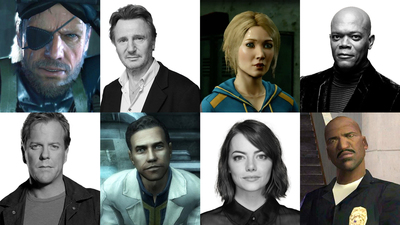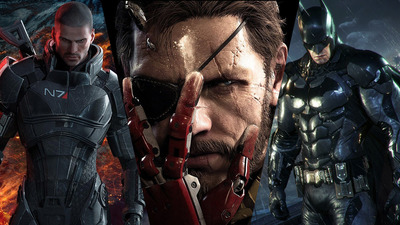
BY JASON GALLAGHER |
Pushing Foward The Art of Character Design: League of Legends Creates Kindred
Find out how League of Legends is pushing character development to the limits.

Video games have slowly gotten better at storytelling over the last decade, and today, many titles create in-depth narratives that wouldn't be out of place in a Hollywood blockbuster. But there are also plenty of games, like Esports titles, where the focus isn't on some larger narrative but the gameplay itself. Still, the best games of this type manage to draw in and hook their player base by writing story around the gameplay. Even if it's just background lore or in-game dialogue, many successful game developers today use at least some form of storytelling to connect the player to the game.
League of Legends is one such game. The title, one of the most popular video games in the world, lets players compete against each other in an online battle arena, using an in-game "champion." Champions are selected from a massive roster and this is where the comparison to Hollywood storytelling begins to diverge. The standard TV show these days may have a half dozen characters that fans consider to be important. Even a show with a large ensemble cast, like say, Game of Thrones, only has maybe a dozen main characters that fans truly care about. League of Legends has nearly 130 and counting. That's 130 characters with background lore, in-game dialogue and other aspects of traditional storytelling that developer Riot Games uses to form an emotional bond between League's in-game characters and its player base.
Perhaps even more impressive is the fact that the number of champions is always going up. (Imagine if your favorite TV show introduced a new main character every two weeks. Things would get complicated quickly.) League of Legends is technically free-to-play, but each champion needs to be unlocked using either in-game or real world currency. Most players tend to settle on a handful of favorites, but Riot periodically releases a new champion in order to give players new options that will keep things feeling fresh.
Last week, Riot released its latest champion: Kindred, the Eternal Hunters. Tribeca caught up with Matthew Dunn, one of Riot's narrative writers for champion design. Dunn, whose background is in traditional screenwriting, gave us a look behind the curtain at Kindred's development, and dived deep into how Riot works hard to tell a story in a video game where competition comes first.
Creating a Framework
Riot's champion creation teams are referred to internally as "pods". Each pod consists of people of different talents who work together to create the new character.
"We have a couple of rules that are kind of central to how we build up a new champion," Dunn said. "Each pod has a core (game) design person, a narrative writer and a concept artist. Those are the fundamental DNA of the pod. Usually we get together and determine what is the framework we want to play in."
Dunn said that while Riot's writers have the freedom to bounce new ideas off of each other whenever they like, each new champion usually starts with a specific gameplay objective in mind. In League, those 130 or so characters are organized into different roles. Some characters excel at dealing damage to the opponent while others focus on assisting their teammates and providing support. When it's time to create a new champion, the team will decide which of the various archetypes they want to focus on. For Kindred, they started with the goal of creating a marksman who could also head into the jungle. In non-League speak, they wanted to build a character that could deal good damage to opponents while also taking out secondary objectives across the map.
Once the parameters are set, the team begins to brainstorm an identity for the new character. It's a process that will sound familiar to anyone who has ever set foot in a Hollywood writers' room.
"Then we kind of progress into what we call open ideation, all of us sitting in a room pitching out ideas," Dunn said. "Then it becomes time for the core design members again to really hone in and ask deep questions about which of these concepts we want to pursue. It's one of the most collaborative processes I've ever been involved in. We usually all want to come to a good consensus."
The Lamb and the Wolf
Kindred, the Eternal Hunters is centered around the concept of death. But early brainstorming sessions produced a wide range of potential champions.
"We iterated a lot, we had a version where it was a cosmic sniper, we had a version where it was a little red-headed girl with some weird kind of magic rune on her hand and a spirit fox, it was very FernGully, very out there, almost Avatar-ish type stuff," Dunn said.
One concept Riot kept returning to for the new character was a person that would be followed by an animal or pet. Dunn said the team had an idea where the player could somehow feed the pet to represent that you were getting stronger, but ultimately decided the "pet" idea wasn't the way to go.
"So we pivoted from pet into what would a partnership look like, two things working in tandem together." he said. "From there, it was one of our artists, he drew a tiny white lamb creature wearing a black wolf mask, shooting a black wolf wearing a white lamb mask out of her bow.
"And we thought.... 'interesting'. To me, this specific pairing of a lamb with a wolf felt very much like a death character."
Dunn said while Riot has designed some other champions that technically use more than one character in certain instances, Kindred is the first time a champion has been fleshed out into two unique but equal partners.
"This is the first time where there are two characters, it wasn't just interesting follow tech, it wasn't just, you're using one of them as an ability," he said. "These characters feel like they are married as one. [It's like] yin and yang, that's one thing but still two halves. It was kind of new for us to do a [champion] on this scale. Kindred was a very, very unique case for us."
Crafting the Champion
With the general concept for Kindred settled on, it was time for Dunn and the rest of the team to make the concept come to life. Dunn said he leans heavily on other forms of media and his own life when trying to flesh out a new champion.
"As a writer I am an avid fan of anything storytelling. I constantly consume video games, movies, television shows, books, plays, comics," he said. "But I think a lot of times the things that impact you the deepest are when you interact with other people. I look to experiences I've had, and I look for similar themes in either shows, or movies or books that I'm reading at the time. That's how I make it personal.
Dunn said he did extensive research on the concept of death, including how it is perceived in different cultures.
"Kindred was one of the characters I probably did the most research on, pulling out books I haven't read since high school, looking through comics I had never read," he said.
Then, it was time for Dunn to start writing while the other members of his pod moved on with their own tasks.
"Design gets to do paper kits where they work out the abilities. Concept art gets to draw. As a writer, you get a little bit left out, we just start doing story sketches," he said. "Which are basically super short stories to see how the character will fit into the world, personality experiments, what kind of stories will bring the character to life. It's our version of concept art. Most of these are never player facing, they're just meant to inspire the team from within."
Dunn estimated he created between 12 to 14 short stories on Kindred from early development through release.
The narrative writers are also heavily involved in crafting the champion's in-game dialogue. Dunn said it can take two to three months for the team to hire the voiceover actors, shoot the script, get feedback and then repeatedly fine tune everything until it sounds just right. Dunn said Kindred was a special challenge in this area because it was more than one character.
"With Kindred, I just thought it would be twice the work, you craft Lamb's lines, you craft Wolf's lines," he said. "[But] then I realize we also have to craft a version of Lamb and Wolf talking to each other. When they speak to each other, it's a unique set of rules of how it's going to work."
Dunn did say the voiceover process and the creative process overall was made a little bit easier thanks to a little inspiration from his wife.
"While trying to figure out what Kindred's relationship looked like, and playing with the idea of complementary personality types, I tended to look at my wife and my relationship a lot. She is very much Lamb, very appreciative, kind of poetic, very organized, rational," he said. "And I tend to be a lot more like Wolf, kind of all over the place."
"When she heard the dialogue she was like, "it's like they're talking about us,' and I was like, 'a little bit', yeah'," Dunn said with a laugh.
Telling Stories Through Gameplay
Riot spends a good deal of time communicating the background and overall concept of each new champion to its players ahead of release. The company has created everything from short stories to music videos in its push to get players to connect with the always-expanding roster of characters.
But the company also understands that not every fan is interested in going outside the game to learn more about a champion's lore or story. Some just want to jump in game with their friends and start melting faces.
Because of this, Dunn said Riot does make an effort to bake at least a little of each character's lore into the gameplay itself.
"Our game is not really a story driven game, it tends to be tricky," he said. "[I've learned] it's more important to ask questions and get the audience asking questions than it is to always answer them. One thing we do and it's always a great gut check during play-testing, is imagine yourself as a random player of any character in the game. And you saw Kindred coming out of the jungle... what would you think? Just by seeing them, what is it you want players to feel? To me it felt like, what is that, why is it haunting me?"
In game, Kindred has an ability where they can announce which champion on the opposing team they intend to kill next, basically calling their shot, Babe Ruth-style. If they succeed, they earn a buff making them more powerful for the rest of the match. Dunn pointed this out as something that will hopefully connect players with the concept of death that the team designed the character around.
"Kindred has this very dramatic moment where they mark you for death. They say basically, we're coming for you," Dunn said. "To me that was a very dramatic moment, that again, as a player it makes me wonder who is this person and why are they coming after me, what have I done?"
LEARN MORE
If you enjoyed this look at the process that led to the creation of Kindred, you won't want to miss Tribeca Games' upcoming event, "The Craft and Creative of League of Legends." Riot developers will be on hand November 13 inside Manhattan's Spring Studios to give players a behind-the-scenes look at the game. Included on the agenda is the panel "Champion Design: Gangplank," which will use everyone's favorite pirate as a case study on how Riot brings a new champion to life.
Check out the full schedule or buy tickets here.

